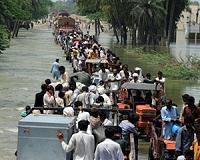| . |  |
. |
East Lansing, MI (SPX) Nov 02, 2010 With big storms ripping across the Midwest, Bob Drost is hoping people are paying attention to the severe weather and tornado warnings. Unfortunately, Drost, a doctoral student at Michigan State University, knows that many times those warnings are ignored, according to his research. "Only 63 percent understood that a warning is the most urgent National Weather Service statement during severe weather," he said. Next week, Drost will present his research findings at the Geological Society of America's annual conference to fellow earth scientists and students. His study split subjects into two groups: those with episodic experience, witnessing tornados firsthand, and those who have semantic experiences or have collected their tornado knowledge from books, television, the Internet, or family and friends. "There's a phenomenon associated with how people react and act to severe storm and tornado warnings," said Drost, who works in MSU's Geocognition Research Laboratory. "Much of it is based on people's prior experience with severe weather. It's comparable to biting into an apple with a worm in it. Eating part of a worm will affect how you decide about eating apples for the rest of your life." Participants with episodic experiences exhibited a lower overall tendency to react to a tornado warning than those who have primarily semantic knowledge of tornadoes. But overall, it was the percentage of people who didn't acknowledge the severity of storm warnings that stood out to Drost. Drost has seen the power of storms firsthand. While observing the arrival of 70 mph straight-line winds, he saw three trees blow over and made it into his house safely before losing his screen door to the storm. While he admits that he is drawn to big weather, he is hoping that his research will improve the National Weather Service's storm warning system as well as how people react to it. "I'm planning on continuing my research on this topic," Drost said. "By working with the scientists and policymakers at organizations like the National Weather Service and National Oceanic and Atmospheric Administration, I'm hoping to find better methods based on social, scientific and cognitive research that will cause people to react appropriately to storm and tornado warnings."
Share This Article With Planet Earth
Related Links Geocognition Research Laboratory Bringing Order To A World Of Disasters A world of storm and tempest When the Earth Quakes
 Pakistan flood victims need aid for two years: aid groups
Pakistan flood victims need aid for two years: aid groupsGeneva (AFP) Nov 1, 2010 Millions of Pakistanis affected by July's devastating floods will need humanitarian assistance for the next two years, with many still trapped by high water, the Red Cross and Red Crescent aid groups said on Monday. Three months on, more than one million people are still living in camps because of high water in southern Sindh province and the situation is repeated in other affected areas, t ... read more |
|
| The content herein, unless otherwise known to be public domain, are Copyright 1995-2010 - SpaceDaily. AFP and UPI Wire Stories are copyright Agence France-Presse and United Press International. ESA Portal Reports are copyright European Space Agency. All NASA sourced material is public domain. Additional copyrights may apply in whole or part to other bona fide parties. Advertising does not imply endorsement,agreement or approval of any opinions, statements or information provided by SpaceDaily on any Web page published or hosted by SpaceDaily. Privacy Statement |